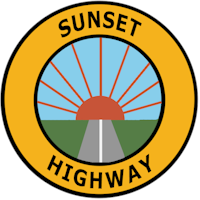
The Historic Sunset Highway
in Washington
"The Trail to Sunset"

The Historic Sunset Highway
in Washington
"The Trail to Sunset"
Old Blewett Pass
Blewett Pass is the section of the Sunset Highway between Cle Elum and Wenatchee. The pass gets its name from Edward Blewett, a Seattle mining promoter of the 1880s. The route over the pass began as an Indian trail, and was first used by miners in 1867 who discovered gold in Swauk Creek. The trail would be used again in 1873 when gold was discovered in Peshastin Creek. In 1873 the Swauk Mining District was formed.
There were no wagon roads through Blewett Pass at the time. Pack trains were used to haul necessary supplies over the old trail for the miners. By the 1890s the Peshastin Mining Camp began major development and the current trails could not keep up with the demand for supplies. A wagon road was now needed.
The narrow canyon on Peshastin Creek just above Ingalls Creek prevented any wagon from getting through from the north. The lumber, steam boilers, stamp mills, trams and cables could not be brought from Wenatchee, and had to come from Ellensburg or Cle Elum.
In 1891 the mining companies in the Peshastin built a wagon road from Mountain Home, up Park Creek over the Wenatchee crest, and down Peshastin Creek to the mines at Culver Gulch. The road followed the old Indian trail, but a series of short switchbacks were needed in the steeper parts of Park Creek and Peshastin Creek. Kittitas County Commissioners were asked to help, but they declined. Miners then each donated one week of labor, and the mining companies donated equipment and supplies to build the road.
In 1892 the Blewett Mining Company bought a major interest in the Peshastin mines, and also assumed responsibility for the road. Also in 1892 further south on Swauk Creek the Swauk mining camp established a post office and the camp came to be called “Liberty."
The Blewett Post Office was established in 1897, when the United States Geological Survey (USGS) made the first map of the area, they named the Peshastin Camp “Blewett” and the old Indian pass over the Wenatchee Range “Blewett Pass.”
In 1915, Washington State was converting the wagon roads into automobile roads. The Sunset Highway originally planned to go over Snoqualmie Pass to Ellensburg then north over Colockum Pass to Wenatchee, go over the Columbia River at Wenatchee and on to Spokane. The only bridge over the Columbia was at Wenatchee. Kittitas County Commissioners had already paid for a survey over Colockum Pass. Cle Elum interests objected as they wanted the road to go over Blewett Pass.
The Commissioners agreed to pay for another survey over Blewett Pass. However, they specified an eight percent grade, the same as the wagon road and too steep for a practical automobile road. Cle Elum interests were incensed and raised money for another survey over Blewett Pass, only this time on a five percent grade. The matter was settled when A. J. Sylvester, the Forest Service Ranger, offered to contribute $1000 toward the cost of the road if it went over the five percent grade on Blewett Pass.
Discussion ended and work begins. The incredibly sharp hairpin curve was named “Echo Point,” not because you can hear an echo there, but because the Cle Elum Echo newspaper was instrumental in organizing local interests to pay for the survey.
The old Blewett Pass highway was a real exciting experience with 248 curves, steep hillsides, lack of guard rails and narrow width. In the 1956 the highway was rerouted over Swauk Pass 4 ½ miles east of Blewett Pass. The pass was 30 feet higher, 4071 ft. vs. 4102 ft., but the grade was much less. When the road was first moved, it was named Swauk Pass for a while. Locals, however, continued to call it the Blewett Pass Highway and finally the state acquiesced. Now the passes are called Old Blewett Pass and Blewett Pass even though it goes over Swauk Pass. What started out as a miner’s wagon road is now a major state highway, SR 97.
You can still drive the Old Blewett Pass Road on a 13 mile portion of the original highway. The road officially became a part of the Sunset Highway in 1922 and paved in 1925. This section of the road has over 57 turns, including hairpin turns, and is a very challenging and enjoyable route. The drivable part now consists of FS 7320 and FS 9715 and is still the original 1925 pavement, and in places the road is now only 1 ½ lanes wide. The pavement surface is not always smooth, it has potholes and bumps, and some rocks and loose gravel on the surface. It will definitely challenge your driving skills. The old road closes for the winter as it is not maintained.
The Colockum Road or the Blewett Pass 1913
Blewett Pass Road Should Be Improved 1914
Proposed Route Between Wenatchee and Ellensburg 1915
Cle Elum Man Writes about Blewett Pass Road 1915
Blewett Pass Road in a Class by Itself 1915
Big Excursion Part at Blewett Sunday 1915
"Echo Point" Name of Curve on Blewett 1922
A Drive on Old Blewett Pass 2016
PDF Files
Mines and Miners of the Swauk by Josee Ann Jordan 1964
Swauk Basin History by Wesley C. Engstrom 2006